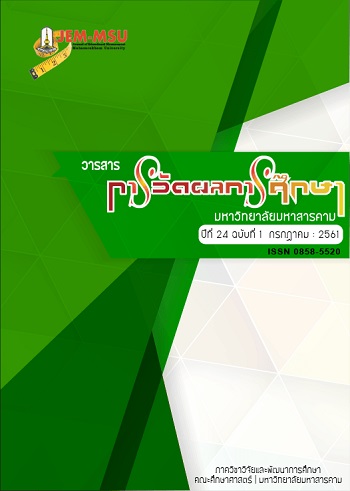The Development of Structural Equation Model of Factors Influencing Public – Consciousness Formation of Non-Formal Students in the Cluster of Nakhonchaiburin
Main Article Content
Abstract
This research aimed: 1) to study of the level of factors influencing public-consciousness
formation of non-formal educational students in the cluster of Nakhonchaiburin, 2) to study
the level of public – consciousness formation of non-formal educational students in the
cluster of Nakhonchaiburin, 3) to examine the goodness-of-fit of the structural equation
model of factors influencing public – consciousness formation of non-formal educational
students in the cluster of Nakhonchaiburin developed by the researcher with empirical data,
and 4) to study the direct effect, indirect effect and total effect of factors influencing public
– consciousness formation for non-formal educational students in the cluster of
Nakhonchaiburin.The samples were 380 non-formal educational students in the cluster of
Nakhonchaiburin, selected by using multi-stage random sampling technique. The instrument
used for collecting the data was a 5-rating scale questionnaire with the discrimination value
between 0.37–0.91 and the reliability at 0.97. The program used for analyzing the descriptive
statistics was SPSS for window and the program used for analyzing the goodness-of-fit of the
structural equation model was LISREL 8.52.
The findings were as follows:
1. The level of factors influencing public – consciousness formation of non-formal
educational students in the cluster of Nakhonchaiburin both in overall and at each aspect
was at the high level.
2. The level of public – consciousness formation of non-formal educational students
in the cluster of Nakhonchaiburin in overall was at the high level.
3. The examination result of the goodness-of-fit of the structural equation model of
factors influencing public – consciousness formation of non-formal educational students in
the cluster of Nakhonchaiburin developed by the researcher with empirical data showed that
the model was consistent with the empirical data (Chi-square = 130.25, df = 110, P =.09,
RMSEA = 0.018, SRMR = 0.024, GFI = 0.98, AGFI = 0.96 and CFI =1.00).
4. The coefficient of direct effect on factors influencing public – consciousness
formation of non-formal educational students in the cluster of Nakhonchaiburin ranging from
high to low were 1) citizenship 2) socialization 3) morality and 4) environment in schools,
respectively.
The coefficient of indirect effect influencing public – consciousness formation of
non-formal educational students in the cluster of Nakhonchaiburin were 1) environment in
schools factor influencing through socialization, morality and citizenship ; 2) socialization
factor influencing through morality and citizenship; and 3) citizenship factor influencing
through morality.
The coefficient of total effect influencing public – consciousness formation of nonformal
educational students in the cluster of Nakhonchaiburin ranging from high to low were
socialization, citizenship, environment in schools and morality, respectivity.
The R2 of structural equation model of factors influencing public – consciousness
formation of non-formal educational students in the cluster of Nakhonchaiburin could
explain the variances of public – consciousness formation with the prediction power of 53 %.
Article Details
The content and information contained in the published article in the Journal of Educational Measurement Mahasarakham University represent the opinions and responsibilities of the authors directly. The editorial board of the journal is not necessarily in agreement with or responsible for any of the content.
The articles, data, content, images, etc. that have been published in the Journal of Educational Measurement Mahasarakham University are copyrighted by the journal. If any individual or organization wishes to reproduce or perform any actions involving the entirety or any part of the content, they must obtain written permission from the Journal of Educational Measurement Mahasarakham University.
References
2. ชัยวัฒน์ ถิระพันธ์. (2542, กรกฎาคม - กันยายน). Chaos Theory กับจุดเปลี่ยนสังคมไทย.
สื่อพลัง. 7(3) : 21 – 27.
3. ชัยวัฒน์ สุทธิรัตน์. (2552). 80 นวัตกรรมการจัดการเรียนรู้ที่เน้นผู้เรียนเป็นสาคัญ. กรุงเทพฯ :
แดเน็กซ์ อินเตอร์คอร์ปอเรชั่น.
4. นงลักษณ์ วิรัชชัย. (2542). โมเดลลิสเรล : สถิติวิเคราะห์สาหรับการวิจัย. พิมพ์ครั้งที่ 3.
กรุงเทพฯ : จุฬาลงกรณ์มหาวิทยาลัย.
5. นงลักษณ์ เขียนงาม และสมพร เมธีวัฒนากุล. (2553). ปัจจัยที่เกี่ยวข้องกับจิตสาธารณะของนักศึกษา
มหาวิทยาลัย. วารสารมหาวิทยาลัยราชภัฏยะลา. 5 (1) : 101-108.
6. ปฬาณี ฐิติวัฒนา. (2542). การพัฒนาสันติสุขด้วยกระบวนการศีลธรรม. กรุงเทพฯ: ภาควิชาสังคม
วิทยาและมานุษยวิทยา มหาวิทยาลัยเกษตรศาสตร์.
7. ปริญญา เทวานฤมิตรกุล. (2554). การศึกษาเพื่อความเป็นพลเมืองศึกษา. (Civic Education).
กรุงเทพฯ : อักษรสัมพันธ์.
8. ประเวศ วะสี. (2541). ยุทธศาสตร์แก้วิกฤตชาติ. กรุงเทพฯ : สถาบันชุมชนท้องถิ่น.
9. ไพบูลย์ วัฒนธรรมศิริ และสังคม สัญจร. (2543). สานึกไทยที่พึงปรารถนา. กรุงเทพฯ : บริษัท
โรงพิมพ์เดือนตุลา.
10. สานักงานคณะกรรมการข้าราชการครู. (2545). พระราชบัญญัติการศึกษาแห่งชาติ พ.ศ. 2542
และที่แก้ไขเพิ่มเติม (ฉบับที่ 2) พ.ศ. 2545. กรุงเทพฯ : พริกหวานกราฟฟิค.
11. Gordon, G. (2004). Moral Reasoning of Young Adults : Political-social Behavior,Family
Background, and Personality Correlates. Journal of Personality and Social
Psychology. 10(3) : 1578-B.
12. Hua, V. & Wan, H. (2011). Global citizenship and the global environment. In Global
citizenship. Edinburgh : Edinburgh University Press.
13. Jones, V. & Morris, V. (1954). Relations of Temperament to the Choice of Values.
Journal of Abnormal Social Psychology. 53 : 781-783.
14. Kraft, P. N. (1992). Social Consciousness through Church Education. [Online]. University
of Pittsburgh. Available from: https://kb.psu.ac.th/psukb/bitstream/2010/7012/10/
[accessed 11 December 2013].
15. Metz, E. & Youniss, J. (2004). A Demonstration that School-based Required Service
does not Deter-but Heightens-Volunteerism. Political Science and Politics.
36(2) : 281-286.
16. Nobira, J. (2007). Buillding Classroom Discipline. 3rded. New York : Longman.
17. Saad, M. A. (1992). The Influence of School Activities of The Students' Needs
Fulfillmnt and Their Moral Development at School : An Exploratory
Study of the Intermediate Stage of the Saudi Arablan Public School
System. Ph.D. (Social Sciences), University of Pittsburgh, U.S.A.
18. Santrock, J. W. (2005). Life-span development. Burr Ridge, Il: McGraw Hill.
19. Smart, D. & Oberklaid, F. (2000). Australian Temperament Project 1983-
2000. Australian Institute of Family Studies : Impact Printing.
20. Shinichi, S. (2007). Knowledge : A Case Study of Communal Land Formation in Rural,
Thailand. Dissertation Abstracts International. 42(05) : 3217 4 A.


